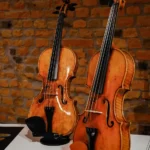What Does the Violin Sound Like?
Back to BlogMusical instruments distinguish themselves by the timbre of their sound, and there is a good amount of violin sound and tones available. So how do you figure out which violin sound or tone is right for you? How does each violin sound differ from each other?
When you start to play the violin, you realize how big and rich each violin sound can be. If you have been a violinist for a while, you can easily distinguish their tones and then understand the market classification for each; although it will vary how each person hears, there’s common sense.
Understanding how the violin sounds and varies in tones
A violin sound depends on the timbre, built over many factors during its making. Timbres, or musical tones, are essential sounds produced by an instrument in pitch and volume. Different instruments can play at the same volume and pitch but sound different.
When a violinist plucks the strings, the vibrations travel through the bridge and into the hollow body. These vibrations release a rich, resonant tone that has made the violin an instrument of grace and beauty. The soundpost transfers the vibrations to the bottom plate of the violin, making it a resonant box. But keep in mind that besides the classifications of the violin sound, it will vary a lot according to the setting, like strings, tailpiece, fine turner, etc., and also the way you play it.
The violin sound – and that of stringed instruments in general – is affected by a number of things, including the thickness of the string, whether it is nylon or steel, where exactly the bow touches the string, how fast the bow moves over the string and how much pressure is applied to the string. Also, the timbre of the violin is not predetermined. No single violin sound predominates in any register. As a result, it is up to the musician to choose the timbre they desire.
Here at Amorim Fine Violins, we have divided our collection into some tones sections:
The Dark Sounding Instruments
A dark sound is a low-level combination of the upper partials and fundamental tones in relation to the lower partials.
A violin that has a dark sound in our collection is a violin by Hyun-Jung Park. A personal line modified on Antonio Stradivari P mold violin. The top is made of spruce from the Val di Fiemme zone in the Italian Alps.
The Bright Sounding Instruments
Violins with full-bodied, resonant tones and fewer overtones are said to be “bright” violins.
A violin sounding bright in our collection is a Violin by Adriano Spadoni. Adriano’s passion for the craft and his obsessive attention to detail make each violin a unique piece.
The Sweet Sounding Instruments
Delicate, like relaxing. Sweet violins’ voices aren’t very strident or piercing, with a high-frequency response.
A violin by Pietro Iotti is an example of the Sweet sound. Inspired by the modern maker Sgarabotto.
The Round Sounding Instruments
Round violins can have a voice defined by their high-frequency roll-off or dip.
This violin by Hiller & Son is one example of an instrument with a round sound. Hiller’s long experience as a violin maker along with his innovative style is demonstrated in this violin.
The Direct Sounding Instruments
Violins with that tone are characterized for having a direct approach, going straightforward and quick response in root position.
A violin sounding direct at Amorim Fine Violins is a violin by Fabio Volta
The Sharp Sounding Instruments
Sharp violins are more high-pitched and strong, and they can come out with a lot of personalities.
A violin sounding sharp in our collection is Andrea Cabrini’s violin.
To sum up, choosing the right and the best violin sound will only depend on you. The most important factor when deciding what kind of sound to make is what kind of sound you like. Ask yourself: Do you enjoy how you sound with your violin? How do you feel when playing for an audience?
Moreover, instruments develop sounds with time. The more you play, the better it sounds. And you can always ask your luthier to make improvements and adjustments.









